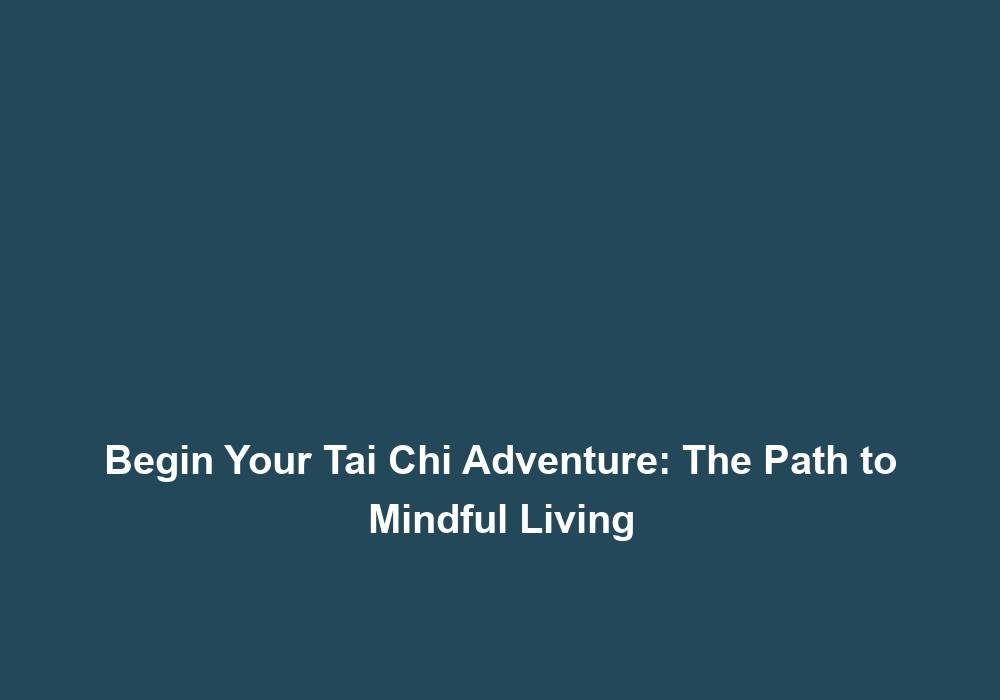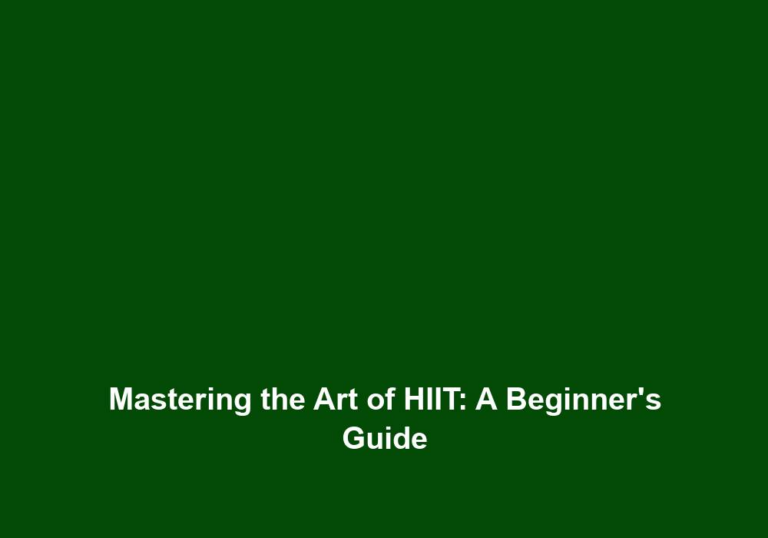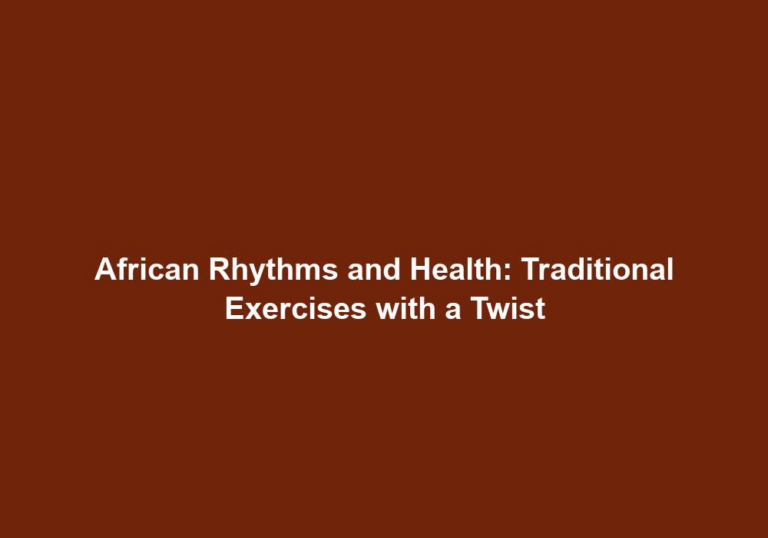Begin Your Tai Chi Adventure: The Path to Mindful Living
Tai Chi, often referred to as moving meditation, is a centuries-old Chinese martial art that promotes physical and mental well-being. With its graceful and flowing movements, this ancient practice has gained immense popularity around the world for its ability to enhance balance, flexibility, and overall mindfulness. Embarking on a Tai Chi adventure can be a transformative experience, leading you on a path to a more serene and mindful life. In this article, we will explore the essence of Tai Chi, its benefits, and how you can start your own Tai Chi journey.
Understanding the Essence of Tai Chi
Tai Chi, also known as Tai Chi Chuan, is a discipline that combines martial arts, philosophy, and traditional Chinese medicine. It originated in China during the 17th century and has since evolved into various styles, such as Yang, Chen, Wu, and Sun. Each style has its unique characteristics, but they all share the fundamental principles of slow, deliberate movements, deep breathing, and a focused mind.
At its core, Tai Chi aims to harmonize the body, mind, and spirit by cultivating qi (pronounced chee), the vital life force that flows through the body’s energy channels. By practicing Tai Chi regularly, you can improve the circulation of qi and promote its optimal flow, leading to a state of balance and inner calm.
Tai Chi is not just a physical exercise, but a holistic practice that incorporates mindfulness and self-awareness. It encourages individuals to be fully present in each movement, focusing on the breath and cultivating a sense of inner peace and stillness. Through this practice, you can develop a heightened sense of body awareness and improve mind-body coordination.
The Benefits of Tai Chi
-
Enhanced Physical Health: Tai Chi is a low-impact exercise that gently works the muscles, joints, and bones without putting excessive strain on the body. The slow and controlled movements help improve flexibility, strength, and cardiovascular fitness. Regular practice of Tai Chi has been shown to alleviate chronic pain, such as arthritis, and improve posture and balance, reducing the risk of falls, especially in older adults.
-
Mental Well-being: The slow and deliberate movements of Tai Chi require focused attention and concentration, creating a meditative state of mind. This mindfulness practice can reduce stress, anxiety, and depression while promoting a sense of tranquility and clarity. Tai Chi has also been found to enhance cognitive function and memory, improving overall mental well-being.
-
Emotional Balance: Tai Chi emphasizes the cultivation of inner peace, resilience, and emotional equilibrium. By integrating breath control, relaxation techniques, and self-awareness, this practice can help manage emotions and foster a positive outlook on life. It provides a safe and nurturing space for individuals to explore and process their emotions, leading to emotional balance and well-being.
-
Social Connection: Joining a Tai Chi class or community can provide a supportive and inclusive environment. Engaging with like-minded individuals who share a passion for Tai Chi can enhance social connections and contribute to overall well-being. It offers an opportunity to connect with others, build meaningful relationships, and share experiences and knowledge about Tai Chi.
-
Mind-Body Connection: Tai Chi encourages a deep connection between the mind and body, promoting self-awareness and self-empowerment. By mindfully moving through the sequences of Tai Chi, you can develop a heightened sense of body awareness and improve the mind-body coordination. This connection allows individuals to better understand and listen to their bodies, leading to improved physical and mental well-being.
Starting Your Tai Chi Journey
If you’re ready to embark on a Tai Chi adventure, here are some steps to get started:
Step 1: Find a Qualified Instructor
To ensure the correct techniques and your safety, it is essential to learn Tai Chi from a qualified instructor. Look for instructors who are certified and experienced in teaching Tai Chi. They should have a thorough understanding of the principles and be able to adapt the practice to your individual needs and abilities. A qualified instructor can provide guidance, correct your posture, and help you progress in your Tai Chi journey effectively.
Step 2: Choose a Tai Chi Style
There are various styles of Tai Chi, each with its unique characteristics and movements. Research and explore different styles to find the one that resonates with you. Popular styles include Yang, Chen, Wu, and Sun. Consider trying out a few classes or workshops to get a feel for each style before committing to one. It’s important to choose a style that suits your preferences and goals.
Step 3: Start with Basics
Begin your Tai Chi journey by mastering the foundational movements and principles. This includes learning proper body alignment, practicing deep breathing techniques, and understanding the core principles of Tai Chi. Starting with a strong foundation will enable you to progress and deepen your practice effectively. Focus on learning the proper posture and alignment of each movement, as this forms the basis for the more complex sequences.
Step 4: Practice Regularly
Consistency is key when it comes to Tai Chi. Aim to practice at least two to three times a week, gradually increasing your practice time as you become more comfortable. The more you practice, the more you will experience the numerous benefits of Tai Chi. Set aside dedicated time for your practice and create a routine that works best for you. It can be helpful to integrate Tai Chi into your daily schedule, making it a regular part of your life.
Step 5: Join a Community
Consider joining a Tai Chi class or community to enhance your learning experience. Practicing with others who share your passion can provide motivation, support, and opportunities for growth. Engaging in group sessions or workshops can deepen your understanding of Tai Chi and allow for valuable interactions with fellow practitioners. It’s a great way to connect with like-minded individuals and learn from each other’s experiences.
Step 6: Embrace Mindfulness
Tai Chi is not just about the physical movements; it is a practice of mindfulness and self-awareness. Embrace the meditative aspects of Tai Chi by focusing on your breath, being fully present in each movement, and cultivating a sense of inner peace and stillness. Pay attention to the sensations in your body, the flow of energy, and the connection between your mind and body. Allow yourself to let go of distractions and be present in the moment.
Conclusion
Embarking on a Tai Chi adventure can lead you to a path of mindful living, enhancing both your physical and mental well-being. By understanding the essence of Tai Chi, its benefits, and following the steps to start your own journey, you can experience the transformative power of this ancient practice. Begin your Tai Chi adventure today and unlock the door to a more balanced, serene, and mindful life.







